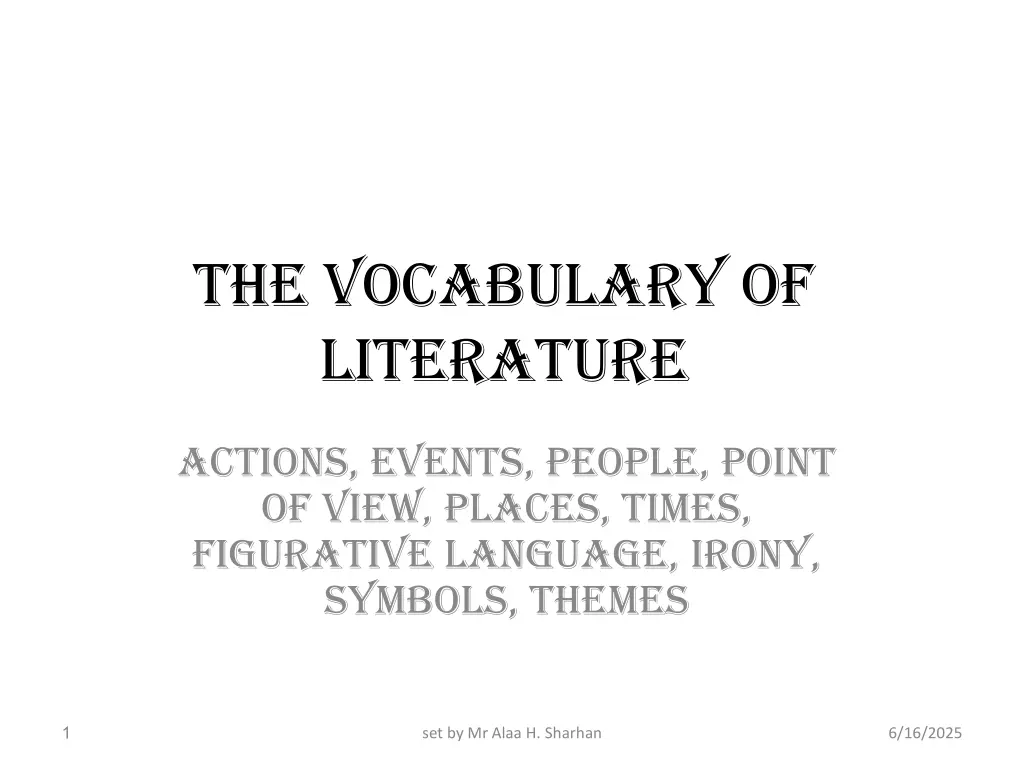
Literature Elements: Actions, People, Point of View, Settings
Explore key elements of literature like actions, characters, narrative perspective, and settings. Understand how these components shape the structure and meaning of literary works. Dive into the world of fiction and uncover the nuances that make stories come alive.
Uploaded on | 1 Views
Download Presentation

Please find below an Image/Link to download the presentation.
The content on the website is provided AS IS for your information and personal use only. It may not be sold, licensed, or shared on other websites without obtaining consent from the author. If you encounter any issues during the download, it is possible that the publisher has removed the file from their server.
You are allowed to download the files provided on this website for personal or commercial use, subject to the condition that they are used lawfully. All files are the property of their respective owners.
The content on the website is provided AS IS for your information and personal use only. It may not be sold, licensed, or shared on other websites without obtaining consent from the author.
E N D
Presentation Transcript
The Vocabulary of Literature Actions, Events, People, Point of view, Places, Times, Figurative Language, Irony, Symbols, Themes 1 set by Mr Alaa H. Sharhan 6/16/2025
Actions and Events Traditional elements of structure are introduction, complications, climax, and conclusion. Introduction is the beginning of the a work, which usually suggests the setting (time and place) and shows one or more of the main characters. Complications are events and actions that establish the conflict in a literary work. Climax is the turning point, often signified by a character s making a significant decision or taking action to resolve a conflict. Conflict is the struggle between internal and external forces in a literary work. Conclusion is the ending of a work, which often shows the effects of the climatic action or decision. Plot is the sequence of actions and events in a literary work. Structure is the pattern formed by events and actions in a literary work. 2 set by Mr Alaa H. Sharhan 6/16/2025
People Characters are the fictional people who are part of the action of a literary work. Motivation is the reason or reasons that cause a character to think, act, or speak in a certain way. Dynamic character is a character who changes in some significant way during the course of the work. Round character is a character who shows many different facets; often presented in depth and with great detail. Flat character is a character who usually has only one outstanding trait or feature. Static character is a character who does not change in any significant way during the course of the work. 3 set by Mr Alaa H. Sharhan 6/16/2025
Point of View Point of view is the position from which the details of the work are reported or described. Narrator is the voice that tells the work of fiction. Omniscient narrator is a narrator who knows everything an can report both external actions and conversations as well as the internal thoughts of all characters and who often provides evaluations and judgments of characters and events. Limited omniscient narrator is a narrator who can report external actions and conversations but who can describe the internal thoughts of only one character. A limited omniscient narrator may offer evaluations and judgments of characters and events. First person narrator is a narrator who is also a character in the work and who uses I or we to tell the story. First person narrators can report their own thoughts but not the thoughts of others. They may offer evaluations and judgments of characters and events. Reliable narrator convinces readers that he or she is reporting events, actions and conversations accurately and without prejudice. Unreliable narrator raises suspicions in the minds of readers that events, actions, and conversations may be reported inaccurately and that evaluations may reflect intentional or unintentional prejudice. Objective narrator is a narrator who, like a camera, shows external events and conversations but cannot look inside the minds of characters or offer evaluations and judgments. 4 set by Mr Alaa H. Sharhan 6/16/2025
Places and Times Setting is the time and place of a literary work. Setting includes social, political, and economic background as well as geographic, physical locations. Exterior setting is aspects of setting that exist outside of characters. Interior setting is aspects of setting that exist inside the minds and hearts of the characters. Flashback is an interruption in the chronological order of a work by description of earlier occurrences. 5 set by Mr Alaa H. Sharhan 6/16/2025
Figurative Language Figurative language refers to words and expressions that carry more than their literal meaning. Metaphor is a comparison of two unlike things. Simile is a comparison of two unlike things, using the words like or as . Apostrophe is the addressing of inanimate object or place as if it were alive. Personification is to give an inanimate object the qualities of a person or animal. Symbol: in a literary work, an object, action, person, or animal may stand for something more than its literal meaning. 6 set by Mr Alaa H. Sharhan 6/16/2025
Irony Verbal Irony is a discrepancy between what is said and what is meant or between what is said and what the reader knows to be true. Irony of situation is a discrepancy between said and what is done or between what is expected and what actually happens. 7 set by Mr Alaa H. Sharhan 6/16/2025
Theme Theme is the central idea examined by a writer in the course of a story. Sometimes the idea is simply explored, its important details laid bare to the reader, but more often the writer presents certain conclusions on his theme or themes. 8 set by Mr Alaa H. Sharhan 6/16/2025
